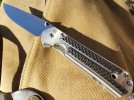- Joined
- Jul 30, 2006
- Messages
- 43,084
So I have a question as I'm not a machinist and have zero knowledge about CNC machines other than what they are and what they do.
How does CRK get such tight and controlled tolerances? Is it due to better equipment, better data/coding input, better materials, better design, or maybe more hand finishing and attention to detail?
Not my area of expertise, but I'll take a high level stab at it. I've set tolerances on a few parts here and there, so I'm not totally unaware of the issues.
Aside from the CNC machine, the tooling and the bit heads must be made to tighter tolerances and replaced more frequently because they wear in use. Wear that would not be noticed if you were holding a 0.005" tolerance is enough to screw up a part if you are holding 0.0001". Obviously replacing these items more frequently adds to the manufacturing cost.
The particular CNC machine being used is also important. There are various CNC machines with varying capabilities as regards holding tolerances. The machines capable of tighter tolerances take significantly longer to machine a given piece.
The precision significantly increases the cost of manufacturing the knife.

